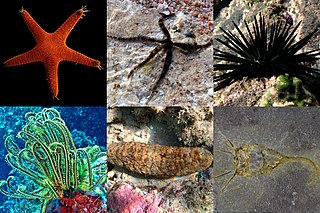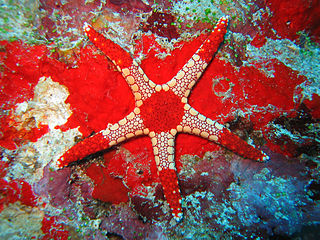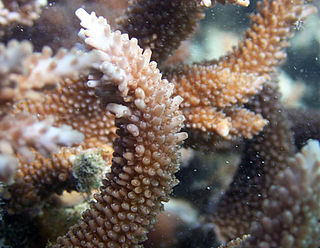
An echinoderm is any deuterostomal animal of the phylum Echinodermata, which includes starfish, brittle stars, sea urchins, sand dollars and sea cucumbers, as well as the sessile sea lilies or "stone lilies". While bilaterally symmetrical as larvae, as adults echinoderms are recognisable by their usually five-pointed radial symmetry, and are found on the sea bed at every ocean depth from the intertidal zone to the abyssal zone. The phylum contains about 7,600 living species, making it the second-largest group of deuterostomes after the chordates, as well as the largest marine-only phylum. The first definitive echinoderms appeared near the start of the Cambrian.

Starfish or sea stars are star-shaped echinoderms belonging to the class Asteroidea. Common usage frequently finds these names being also applied to ophiuroids, which are correctly referred to as brittle stars or basket stars. Starfish are also known as asteroids due to being in the class Asteroidea. About 1,900 species of starfish live on the seabed in all the world's oceans, from warm, tropical zones to frigid, polar regions. They are found from the intertidal zone down to abyssal depths, at 6,000 m (20,000 ft) below the surface.

Asterias amurensis, also known as the Northern Pacific seastar and Japanese common starfish, is a seastar found in shallow seas and estuaries, native to the coasts of northern China, Korea, far eastern Russia, Japan, Alaska, the Aleutian Islands and British Columbia in Canada. Two forms are recognised: the nominate and formarobusta from the Strait of Tartary. It mostly preys on large bivalve molluscs, and it is mostly preyed on by other species of starfish. Population booms in Japan can affect the harvest of mariculture operations and are costly to combat.

Culcita novaeguineae is a species of starfish. It has short arms and an inflated appearance and resembles a pentagonal pincushion. It is variable in colour and can be found in tropical warm waters in the Indo-Pacific.

Culcita is a genus of sea stars. They are found in tropical waters. Some are kept in home aquariums.

Culcita schmideliana, commonly known as the spiny cushion star, is a species of pin-cushion star. It has a variety of base colors and often patches of a different color. It is pentagonal in shape and lives in the tropical Indo-Pacific. This species is rarely kept by hobby aquarists.

Toxopneustes pileolus, commonly known as the flower urchin, is a widespread and commonly encountered species of sea urchin from the Indo-West Pacific. It is considered highly dangerous, as it is capable of delivering extremely painful and medically significant stings when touched. It inhabits coral reefs, seagrass beds, and rocky or sandy environments at depths of up to 90 m (295 ft). It feeds on algae, bryozoans, and organic detritus.

Fromia monilis, common name necklace starfish or tiled starfish, is a species of starfish belonging to the family Goniasteridae.

Fromia milleporella, common name red starfish or black spotted starfish, is a species of starfish belonging to the family Goniasteridae.

Aquilonastra conandae is a species of starfish from the family Asterinidae found near the Mascarene Islands in the Indian Ocean. It is known for its asexual reproduction and is fissiparous. It is a small starfish, discrete and camouflaged, and occurs in coral reefs in the surf zone of large waves. The species was described in 2006 by Australian marine biologists P. Mark O'Loughlin and Francis Winston Edric Rowe, and gets its name from Chantal Conand.

Acropora acuminata is a species of acroporid coral found in Australia, the Red Sea, the central Indo-Pacific, Japan, the northern Indian Ocean, the East China Sea, southeast Asia, and the western Pacific Ocean. It is particularly susceptible to coral bleaching, the crown-of-thorns sea star, and harvesting for the aquarium trade. It is found on shallow coral reefs from depths of 5–20 m. It was described by Addison Emery Verrill in 1864.

Fromia elegans, common name little red star, is a species of marine starfish belonging to the family Goniasteridae.

Fromia ghardaqana, common name Ghardaqa sea star, is a species of marine starfish in the family Goniasteridae.

Fromia polypora, commonly called many-pored sea star or many-spotted seastar, is a species of marine starfish belonging to the family Goniasteridae.

Fromia nodosa, commonly called elegant sea star, is a species of marine starfish belonging to the family Goniasteridae.
Red starfish is a common name for several starfish and may refer to:
Ailsa McGown Clark (1926–2014) was a British zoologist, who principally studied echinoderms and was a specialist on asteroidea. She worked at the Natural History Museum for most of her career.
Maureen Elizabeth Downey was an American zoologist who worked for three decades at the Smithsonian National Museum of Natural History. Known as "The Starfish Lady," she was an authority on sea stars and other echinoderms, co-founding the International Echinoderm Conference in 1972. Among her discoveries is Midgardia xandaros, the world's largest starfish.
Helen Elizabeth Shearburn Rotman was a New Zealand expert on echinoderms, specifically starfish.



















